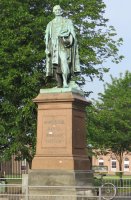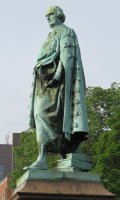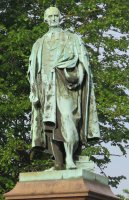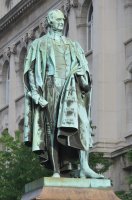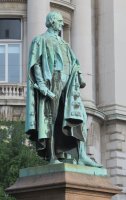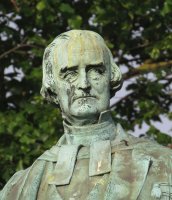Henry Cooke statue, College Square East, Belfast
In College Square East, in Belfast City Centre west of the City Hall, stands a bronze statue of Henry Cooke, by the Irish-born sculptor Samuel Ferris Lynn.
Henry Cooke, College Square East
In College Square East, Belfast, stands a fine bronze statue of Henry Cooke, wearing academic robe and religious collar, and with his scholar’s cap held in one hand, some small folded paper in his other. He is shown in later middle age, creased round eyes and mouth, a high forehead with hair swept back. The pose is typical, one foot advanced, staring outward and slightly downward and to the side, a purposeful demeanour, and the figure is given interest by his robe being caught over his arm and cap so the folds sweep across his front, and by the sculptor making much of the many tassels on the robe, which give a more complex surface with shadows satisfying to the eye. A heap of three books, big, scholarly tombs with heavy bindings, are at his feet, indicative of scholarly leanings and his own many publications.
The statue is dated 1875, and was erected the following year, and the high, square plinth it stands on – red granite on the top, stone at the base, is from an earlier statue – the front must have been replaced or recut – to the Earl of Belfast, known as the Black Man; apparently the Cooke statue has kept the name, despite the colour being green patina bronze. It was cast in Southwark, London, by the founder H. Prince who signs on the base.
The sculptor, whose name is on the other side, was Samuel Ferris Lynn, brother to a Belfast architect who lived most of his life in London and returned to live in Belfast only at the end of his short life. The Cooke statue, erected in the year of the sculptor’s death, is one of two major works by Lynn in the city, the other being the Prince Albert for the Albert Clock Tower. More on Lynn on this page.
Cooke was a Presbyterian minister of great influence, who quarrelled with the Academical Institution in front of which his statue stands: it has been suggested that his facing away from the building is to symbolise this argument, but it is really rather normal for statues to face forward to the street rather than the reverse.
